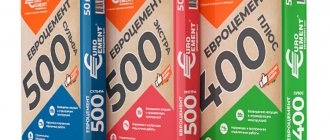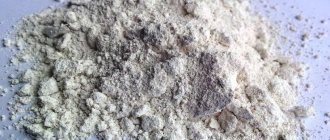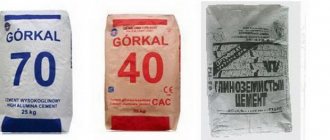The white variety of Portland cement has been available to humans for over a hundred years. A characteristic feature of this material is its aesthetic and decorative features. The first types of cement were produced of low quality, but nowadays technologies are being improved and new equipment is appearing. All this “revived” white cement, which, moreover, became of better quality. Now, in addition to the decorative component, the material has good technical properties, namely, it is able to withstand high loads, which has affected its distribution.
Figure 1. White cement
Where is white cement used?
White cement is widely used. It is found in almost every building, and sometimes its use becomes the only solution. Areas of application:
- A variety of building elements are made from it. White cement is often used for finishing facades. It makes the structures under construction more durable and expressive;
- Thanks to its good technical characteristics, the material is in demand for work both outside and inside buildings. The fact is that the color of white concrete does not change after years of use, despite the aggressive effects of various atmospheric phenomena;
- white cement is popular among architects and manufacturers of cement products, as it makes it possible to turn interesting ideas into reality. So, shapes, fillers, and colors change. The hardened surface is also treated in different ways;
- it is used to produce ready-made plaster, mortars, dry mixtures and materials for filling joints;
- develop elements of park and garden furniture, artistic products;
- White cement is used to make flooring materials, for example, colored paving slabs;
- applicable if it is necessary to restore a historical relic.
Important! The wide range of applications is explained both by the technical characteristics of the material and by its visual appeal - whiteness. To maintain the whitish tint, no additional protective measures are required.
Application area
This type of cement is successfully used for finishing buildings, the architectural fragments of which are impressive with their whiteness and are distinguished by their durability. It is also used to create terrazite plaster, which is used for cladding buildings, as well as for paving slabs and decorative bricks.
White cement serves as the basis for the manufacture of self-leveling floors, decorative mixtures, and adhesives. With its help, all kinds of small architectural forms, columns, sculptures, flower beds, balconies, etc. are created.
Today, this material has become popular among artists who create unique masterpieces by adding cement to composite marble.
Advantages and disadvantages
Figure 2. Application of white cement
Compared to gray varieties, white cement has a lot of positive properties that only expand its scope of application:
- hardens quickly. 16 hours after pouring, the material gains 60% strength. Gray cement requires a minimum of 3 to 4 weeks. Thanks to the rapid hardening of concrete, builders gain a lot of time;
- high dispersion index, protecting products from negative atmospheric influences. The color of the cement will remain the same, even if the material is exposed to snow, rain, or sunlight for a long time. Natural factors of destruction also appear much later than in classical concrete;
- Compared to gray cement, white has twice the resistance to cracking. The fact is that the material is made from high-quality clinker with less added impurities;
- environmentally friendly. The raw materials for production are those that occur naturally;
- attractive appearance. White surfaces are easier to combine with finishing, and they look brighter than being gray.
If you add natural pigments to the mix, you can paint the product a different color. Options for additives and what color they give: red lead, ocher – yellow, cobalt – blue, manganese carbonate – black.
One of the significant disadvantages of white cement, which is also called decorative, is its high price (almost 25% more expensive than gray cement). Also, mixtures, both ready-made and dry, need protection from foreign inclusions. That is, you cannot prepare cement using dirty tools with rust. Reinforcement work also becomes more complicated - the rods must be protected from rust.
Due to the high cost and complexity of work, in Russia 1-2 bags of white are required per 100 bags of gray cement. However, construction and finishing technologies do not stand still, and they are pushing the industry towards new trends and solutions.
Figure 2. White cement buildings
Safety precautions
When mixing the solution, it is very important to follow safety rules to avoid injury. Eyes must be protected from cement dust with special glasses, and a respirator or mask will help prevent it from entering the respiratory system. You should wear gloves on your hands. If you have to use a concrete mixer for mixing, it is recommended to use noise-reducing headphones.
Today, thanks to the Internet, it is possible to order white cement from almost anywhere in the country. Whether it is Moscow, Yekaterinburg or any other city is not so important - delivery is carried out quite quickly, and payment can be made in a variety of ways.
Manufacturing technology
In order to obtain white cement, you need to grind low-iron white clinker, mineral gypsum additives and include colored pigments in the composition. The following materials are used as raw materials: limestone, clay, sand (they should have a low content of titanium, iron and manganese).
The raw materials are annealed using ash-free fuel, that is, fuel oil or gas. To simplify this procedure, a mineralizer in the form of fluorspar or sodium silicofluoride is added to the mixture. White cements differ in the degree of whiteness. This parameter depends on the characteristics of the clinker used in production.
First, the composition is fired at a temperature of +1200 degrees Celsius, then, to make the finished solution strong, it is cooled to +200 degrees. By using special mills, it is possible to achieve fine grinding of clinker - 4500 cm2/g (for the gray variety this parameter is 3500 cm2/g).
Depending on the degree of moisture of the raw material, two different methods are used to produce such material as white cement:
- dry. It is used if the raw materials have a low degree of humidity. In special shaft furnaces, the components are ground, dried and mixed. The resulting clinker is fired at a temperature of +800 degrees;
- wet. In this scheme, hard components are crushed with special mills, soft components are crushed in mash jars with the addition of water. Next, the wet raw material is dried, ground and mixed with other components, similar to the dry method.
Important! The finished material differs in the degree of whiteness and according to this indicator is divided into three classes. If desired, you can enhance the decorative effect by adding dyes and marble chips to the cement.
Characteristics and composition
White cement is a building material that is gaining popularity. It differs from the traditional analogue in composition, manufacturing process, operational and aesthetic characteristics and, of course, color. The substance is astringent, powdery, and when mixed with water it instantly hardens, forming a tight elastic mass. The whitish, pleasant shade is achieved through components with a minimum amount of ferrous compounds (manganese, chromium, iron, titanium).
The substance is based on low-iron clinker, as well as limestone rocks (chalk, limestone, marl, marble), clay, sand, gypsum, and chloric salts. Iron oxide should contain less than 0.45% of the total mass.
The strength of white cement is twice that of gray cement. This level can be achieved by sharply cooling the clinker after firing in an oxygen-free environment. Liquid fuel and gas burners are suitable for firing.
Grinding of clinker and crushing of raw materials occurs in mills or crushers with a special lining using basalt, silicon or porcelain slabs.
In order for cement to fully cope with its functions, strict requirements are imposed on its composition, including high quality ingredients. The clay component is primary and enriched (slip) kaolins. The slip consists of tiny quartz grains with an admixture of mica and kaolinite. It is better to avoid large grains of sand: they slow down the transportation and mixing of the mixture.
White cement is marked in two ways - M500, M400, less often - M600, M700.
According to the saturation of the shade (degree of whiteness), three types are distinguished:
- 1st grade - reflection coefficient - 80-85%.
- 2nd grade - 75%.
- 3rd grade - 68%. When the reflectivity exceeds 90%, the cement is classified as premium class.
White cement brands
The grade designated by the letter “M” characterizes the strength of cement. The following brands are available:
- M400 - of all possible ones, it has the lowest strength, shrinks and has low sulfate resistance;
- M500 – durable and frost-resistant mortar with low deformation;
- white cement class M600 is frost-resistant, hardens quickly and practically does not “shrink”;
- M700 is a modern and innovative variety, a kind of European standard.
In finishing and construction work, the most popular grades are M500 and 600.
Application tips from professionals
To achieve the best results, you need to know the basic rules for working with white cements:
- When preparing raw materials with your own hands, you should make sure that the containers and working tools are clean (not covered with dirt, dust, rust). The same goes for a concrete mixer;
- mix and moisten the solution using only clean water;
- If the structure being built is reinforced with steel reinforcement, it is additionally protected with concrete, a layer of 30 mm. If this is neglected, the white surface may become “decorated” with rusty stains over time;
- Titanium dioxide is sometimes used as a whitening additive. True, you shouldn’t overdo it - no more than 1% of the total mass is enough;
- When preparing, select fine-grained aggregate, always white, with dimensions up to 2 mm. There should be no silty particles or fine earth in it. If quartz sand is used, it must be free of sulfide minerals;
- When choosing a plasticizer, you should also focus on color. If the whitening is based on zinc, it is better to prefer a different option.
By following the above rules, you can be sure that the end result will be an environmentally friendly and beautiful white material that will be useful in finishing and construction work.
What to consider when mixing the composition
White cement must be mixed under specific conditions. It will change properties upon close contact with fat. That is why, when mixing material, you need to take clean tools and containers. In addition, it is recommended to degrease them before use. Metal surfaces must be treated with anti-corrosion compounds. They are applied in a thin layer. Otherwise, the resulting rust will penetrate the concrete structure and will be visible from the outside. Of course, this will not happen immediately, but after some period of time it will definitely happen.
Otherwise, this type of cement is identical to conventional material. You can easily prepare it yourself. Clean river sand can be used to fill the cement.
To produce the composition, standard doses are required: one to three. Mixing this composition will not cause any particular difficulties even for the most inexperienced person. You don't need any special skill here either.











